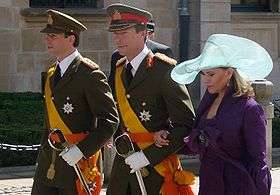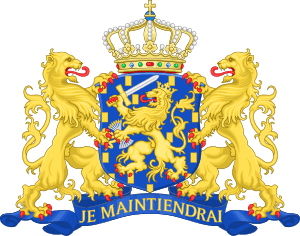Order of the Gold Lion of the House of Nassau
| Order of the Gold Lion of the House of Nassau Ordre du Lion d'Or de la Maison de Nassau Huisorde van de Gouden Leeuw van Nassau | |
|---|---|
 | |
| Plaque, badge and ribbon of the Order of the Gold Lion of the House of Nassau | |
| Awarded by Grand Duke of Luxembourg King of the Netherlands | |
| Type | Luxembourg: National Order Netherlands: House Order |
| Motto | JE MAINTIENDRAI |
| Awarded for | Luxembourg: for foreign sovereigns, princes of sovereign houses, and heads of state that displayed meritous service to Luxembourg and the Grand Duke Netherlands: for people who have rendered special service to the Royal House |
| Status | Currently constituted |
| Sovereign | His Majesty King Willem-Alexander of the Netherlands His Royal Highness Grand Duke Henri of Luxembourg |
| Chancellor | Henri Ahlborn |
| Grades (w/ post-nominals) | Knight |
| Former grades | Knight Grand Cross, Grand Officer, Officer, Knight, Commander |
| Established | 31 March 1858 |
| Precedence | |
| Next (higher) | Luxembourg: None (highest) Netherlands: Order of Orange-Nassau |
| Next (lower) | Luxembourg: Order of Adolphe of Nassau Netherlands: Order of the House of Orange |
| | |
| Ribbon bar of the Order of the Gold Lion of the House of Nassau | |
The Order of the Gold Lion of the House of Nassau (French: Ordre du Lion d'Or de la Maison de Nassau, Dutch: (Huis)orde van de Gouden Leeuw van Nassau) is a chivalric order shared by the two branches (the Ottonian and Walram lines) of the House of Nassau.
In the capacity of the Walram line the Order of the Gold Lion of the House of Nassau is the highest Luxembourgian national order, bestowed by the Grand Duke of Luxembourg.[1] It may be awarded on foreign sovereigns, princes of sovereign houses, and heads of state for meritous service to Luxembourg and the Grand Duke.[1]
In the capacity of the Ottonian line the order is a house order or dynastic order of the Dutch Royal House of Orange-Nassau, awarded as a personal gift by the King of the Netherlands. In this case the honour is conferred on a person who have rendered special service to the Royal House.[2]
History
1858 – 1892
The order was founded by Grand Ducal decree on 31 March 1858 by King-Grand Duke William III. The honour was to be shared between both branches of the House of Nassau, under agreement between William, King of the Netherlands and Grand Duke of Luxembourg, and Adolphe, Duke of Nassau and future Grand Duke of Luxembourg.[1] The order originally included only one grade, but this was increased to four by William III in 1873:
- Grand Cross
- Grand Officer
- Officer
- Knight
The further (lower) rank of Commander ( in between 2 & 3) was introduced in 1882.[1]
1892 – present
None of the changes made by William III were confirmed by Adolphe, with whom the order was supposed to be shared, and Adolphe refused to award any of the new grades.[1] When William died without a male heir, the Grand Duchy of Luxembourg passed to Adolphe, as dictated by the Nassau Family Pact. Two years later, he abolished the grades that William had created unilaterally, and, to this day, the order has maintained just one grade, i.e. that of Knight.[1] In 1905, Adolphe agreed with Queen Wilhelmina of the Netherlands to once again share the order between both ruling branches of the House of Nassau.[1]
At the present King Willem-Alexander of the Netherlands as well Grand Duke Henri of Luxembourg are joint Grand Masters of the Order of the Golden Lion of Nassau.
The order is awarded only on rare occasions in the Netherlands or Luxembourg. For example, the former Dutch Foreign Secretaries Max van der Stoel and Pieter Kooijmans have been made a knight of this order by the Queen of the Netherlands. The two Grand Masters made the South African President Nelson Mandela a knight during his state-visit in 1999 to the Netherlands (see Nelson Mandela awards).
Insignia
The knight wears the badge on a sash on the right shoulder, and the star of the order on the left chest.
- The badge of the order is a white-enamelled golden Maltese Cross, with the golden monogram "N" between the arms of the cross. The obverse central disc is in blue enamel, bearing the Gold Lion of the House of Nassau. The reverse central disc is also blue enamelled, with the motto "Je maintiendrai" (I will maintain) in gold.
- The plaque is an 8-pointed star with straight silver rays; the same obverse of the badge of the order appears at its centre, surrounded by the motto "Je maintiendrai (I will maintain) in gold letters on white enamel.
- The ribbon of the sash of the order is yellow-orange moiré with a small blue stripe at each edge.
Award criteria

See also : Category:Knights of the Order of the Gold Lion of the House of Nassau
"Honorary distinctions of the Grand Duchy of Luxembourg":[1]
The Order of the Gold Lion of the House of Nassau can be conferred on sovereigns and on princes of sovereign houses and, nowadays, also on heads of state, for meritorious service to the Grand Duke and country. The bestowal of the insignia is carried out by the Grand Duke or his specially appointed official representative. The brevet is awarded in agreement with the head of the Ottonian branch of the House of Nassau (The Netherlands).
Princes and Princesses of the House of Nassau
The princes—sons and brothers of the heads of the two lines of the House of Nassau—are born knights of the order.[1] In 1984, Queen Beatrix and Grand Duke Jean made an agreement that princesses (daughters of the Heads of the House of Nassau) receive the order at majority age (18).[2] Princess Alexandra of Luxembourg received hers on her 18th birthday on 16 February 2009. And now that King Willem-Alexander of the Netherlands is the head of the Dutch branch, his daughters Catharina-Amalia, Princess of Orange, Princess Alexia of the Netherlands and Princess Ariane of the Netherlands are also entitled to receive it on their 18th birthday.
References
- Legislative texts (French and German):
- Constitution, Art. 41. "The Grand-Duke awards the civil and military orders, while observing about this what the law provides."
- Constitution, Art. 45. "The dispositions taken by the Grand-Duc must be counter-signed by a responsible member of the Government."
- Mémorial A n° 48 of 27.11.1857, Ordonnance royale grand-ducale du 25 novembre 1857 concernant les ordres civils et militaires (General provision about orders in Luxembourg)
- Mémorial A n° 13 of 05.05.1858, Arrêté royal grand-ducal du 31 mars 1858 concernant l'institution d'un Ordre commun aux deux branches de la Maison de Nassau, sous le nom de: «Ordre du Lion d'or de la Maison de Nassau» (Foundation of the Order)
- Mémorial A n° 10 of 28.03.1873, Arrêté royal grand-ducal du 13 mars 1873 concernant l'ordre du Lion d'or de la Maison de Nassau (Creation of new classes in 1873)
- Mémorial A n° 24 du 07.04.1882, Arrêté royal grand-ducal du 29 mars 1882 portant modification des statuts de l'Ordre du Lion d'or de la Maison de Nassau (Modification of statutes )
- Mémorial A n° 10 of 05.03.1892, Arrêté grand-ducal du 22 février 1892 modifiant les statuts de l'ordre du Lion d'or de la Maison de Nassau (Statutes)
- Mémorial A n° 48 of 07.09.1905 Arrêté grand-ducal du 27 août 1905 concernant l'Ordre du Lion d'Or de la Maison de Nassau
- 1 2 3 4 5 6 7 8 9 "Honorary distinctions of the Grand Duchy of Luxembourg" (PDF). Service Information et Presse. Retrieved 2007-09-21.
- 1 2 Orders for services to the Royal House - description at the website of the Dutch Royal House (Dutch language)


